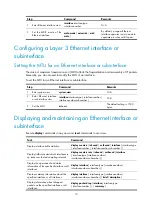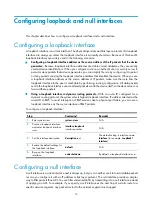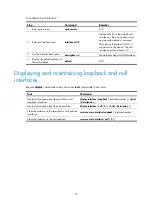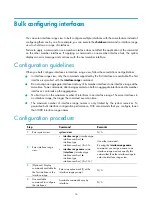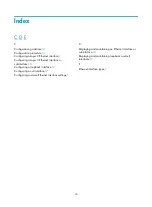
5
Step Command
Remarks
1.
Enter system view.
system-view
N/A
2.
Enter Ethernet
interface view.
interface
interface-type
interface-number
N/A
3.
Set the link-down
event suppression
interval.
link-delay
delay-time
The default setting is 1 second.
With this command configured, when the
interface comes down, the link-down event is not
reported to the CPU until the interface is still down
when the suppression interval (
delay-time
) expires.
When the interface goes up, the link-up event is
immediately reported.
This feature is not supported in the current software
version. The feature is reserved for future support.
4.
Set the link-up event
suppression interval.
link-delay
delay-time
mode
up
The default setting is 1 second.
With this command configured, when the
interface goes up, the link-up event is not reported
to the CPU until the interface is still up when the
suppression interval (
delay-time
) expires. When
the interface comes down, the link-down event is
immediately reported.
This feature is not supported in the current software
version. The feature is reserved for future support.
5.
Set the link-updown
event suppression
interval.
link-delay
delay-time
mode
updown
The default setting is 1 second.
With this command configured, when the
interface comes down or goes up, the link-updown
event is not reported to the CPU until the interface
is still down or up when the suppression interval
(
delay-time
) expires.
If you configure the
link-delay delay
-time
mode updown
command multiple times, the most recent
configuration takes effect.
Do not configure physical state change suppression on a port with MSTP enabled.
Performing a loopback test on an Ethernet interface
If an Ethernet interface does not work normally, you can perform a loopback test on it to identify the
problem. An Ethernet interface in a loopback test does not forward data traffic.
Loopback tests fall into the following types:
•
Internal loopback test
—Tests all on-chip functions related to Ethernet interfaces.
•
External loopback test
—Tests the hardware of Ethernet interfaces. To perform an external loopback
test on an Ethernet interface, connect a loopback plug to the Ethernet interface. The device sends
test packets out of the interface, which are expected to loop over the plug and back to the interface.
If the interface fails to receive any test packets, the hardware of the interface is faulty.
Configuration restrictions and guidelines
•
On a physically down interface (displayed as in
DOWN
state), you can only perform an internal
loopback test, and an external loopback test will fail. On an administratively shut down interface

















